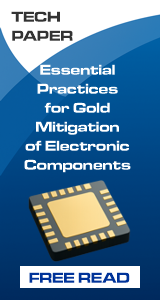| Sponsor |

|
Start Micro Dispensing Today
The DL Micro Valve is specifically designed for dispensing micro volumes of material in precise, repeatable patterns. Learn more about the DL Micro Valve.
DL Technology
|
|
| Sponsor |

|
Understanding Solder Dross: Causes and Control Strategies
This article outlines the main contributors to dross formation, examines how alloy refining methods play a role, and explores practical ways to reduce dross through process control and equipment optimization.
AIM Solder
|
|
Impact of Stencil Manufacturing Technology of Multi-level/ Step Stencils
In this paper, we evaluate and compare the print performance of four different step technologies: Chemically etched, Laser weld, Milled, and Electroform.
Analysis Lab
DOWNLOAD
|
Authored By:
Supriya Agrawal, Mohammad S Alam, Sih Fei Lim, Li Cheng Khaw
Intel Corporation
OR, USA
Summary
Optimization of stencil aperture and thickness for each component on a Printed Circuit Board (PCB) is critical to ensure high product quality and maximize yield. As per IPC, one of the key considerations while designing stencils is to maintain an area ratio (AR) above 0.66 for acceptable paste release [3]. A step stencil is required when a single stencil thickness is not able to meet the AR requirements for certain fine pitch or smaller components while still having to accommodate high paste volume requirements for larger components like headers and connectors.
As PCBA complexity increases, using multiple thicknesses or levels within a stencil is common. Densely designed PCBs and multi-level stencils could lead to an increased risk of solder paste variation on components that are close to the step edge leading to solder joint defects. Traditional methods (such as the chemical etch process) of manufacturing step stencils do not address these challenges. Recent advances in manufacturing technology have necessitated the exploration and adoption of improved step stencil technology.
In this paper, we evaluate and compare the print performance of four different step technologies: a) Chemically etched (CE), b) Laser weld (LW), c) Milled (ML), and d) Electroform (EF). We also study the capability and limitations of four suppliers to manufacture each step technology.
The results indicate that the Milled stencil performs better than other step technologies against a weighted criterion. However, when choosing a step technology, it becomes important to assess suppliers’ capability to manufacture that technology. We find that suppliers tend to be uniquely capable of manufacturing one technology and may not be versatile in manufacturing multiple technologies.
Conclusions
Milled stencil technology showed the capability to meet the technical requirements outlined in our work. The weighted score from critical parameters indicates that Milled step technology outperforms other step technologies in many areas and has a lot of potential to meet future stencil requirements. Milled stencils provide tighter paste Volume% distribution, smooth step transition, and smoother surface finish in addition to all benefits of laser-cut stencils. The cost of milled stencils is comparable to other low-cost step technologies like laser weld and chem-etch stencils. It has the potential to maintain the lowest KOZ which continues to be a critical requirement as we move towards densely populated, mixed-part technology product boards.
Careful considerations should be given to supplier capability before selecting the stencil technology. Results indicated that step technology performance is highly dependent on the stencil supplier’s capability. We found that each supplier excelled in manufacturing a certain step technology, but they may not be versatile enough to manufacture multiple types of step technology. Thus, when choosing a step technology, it is important to choose the best technology, but at the same time, a thorough assessment of suppliers’ capability to manufacture that technology should be done.
Initially Published in the SMTA Proceedings
|
Free Newsletter Subscription
Circuitnet is built for professionals who bear the responsibility of looking ahead, imagining the future, and preparing for it.
Insert Your Email Address
|
| Sponsor |

|
5 Keys to Component Lead Tinning Success
Re-conditioning of electronic components mitigates gold embrittlement, eliminates tin whiskers enhancing quality and sustainability prior to soldering.
BEST Inc.
|
|
|
